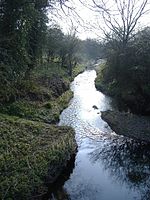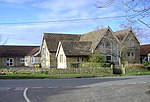Little Somerford
Civil parishes in WiltshireEngvarB from August 2019OpenDomesdayVillages in Wiltshire

Little Somerford is a village and civil parish in Wiltshire, England, 3 miles (4.8 km) southeast of Malmesbury and 7.5 miles (12.1 km) northeast of Chippenham. The northern boundary of the parish follows approximately the B4040 Malmesbury–Swindon road. The Bristol Avon forms part of the boundary to the west and south, and its tributary the Brinkworth Brook forms part of the southeastern boundary.
Excerpt from the Wikipedia article Little Somerford (License: CC BY-SA 3.0, Authors, Images).Little Somerford
Park Lane,
Geographical coordinates (GPS) Address Nearby Places Show on map
Geographical coordinates (GPS)
| Latitude | Longitude |
|---|---|
| N 51.558 ° | E -2.048 ° |
Address
Park Lane
Park Lane
SN15 5JW , Little Somerford
England, United Kingdom
Open on Google Maps









